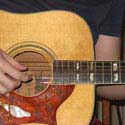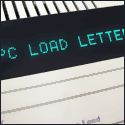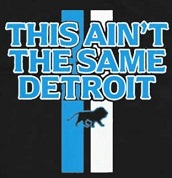|
Would someone give me some advice on how I should mix my track properly? I'm just learning about things like compression, EQ, normalizing audio files... it's all a little bit much and some help would be great. I'll just post my finished track http://michaelmaurer.net/Michael_Maurer_-_Wir_gehen_im_Herbst_spazieren.mp3 and here's a screenshot of my reason setup (w annotation) http://michaelmaurer.net/song_reason.png mike12345 fucked around with this message at 12:06 on Oct 26, 2009 |
|
|
|

|
| # ? May 12, 2024 14:11 |
|
Can anyone tell me if it's possible to get a feedback sound out of a software amp and effects setup? I'm using Ableton Live with FreeAmp3, an acoustic with a pickup, and apart from headphones the closest thing I've got to monitors is a lovely pair of computer speakers. I'm doing really dirty, nasty sounding slide guitar with a fair bit of distortion and trying to get some feedback type sounds going on long, sustained notes. Does anyone know if there's a way to simulate feedback at all, or is my best bet going to be trying to get some going with these dinky little 4" speakers?
|
|
|
|
nrr posted:Can anyone tell me if it's possible to get a feedback sound out of a software amp and effects setup? I'm using Ableton Live with FreeAmp3, an acoustic with a pickup, and apart from headphones the closest thing I've got to monitors is a lovely pair of computer speakers. Not really, although I get some using the Rocktron PRO GAP ULTRA I bought from Agreed. It's not true feed back, though; more like harmonics that creep in on sustained notes due to being high-gain. True feedback is strings feeding back due to the sound waves from the amp reinforcing the vibrations of the strings. You're not going to get this without some real volume (which determines strength of said sound waves). However google turned up this: http://www.softube.com/acoustic_feedback/ youtube demos sound usable enough to me. Pretty cool little effect, really.
|
|
|
|
I'm gonna rephrase my question from the last page: Will a new 27" iMac rock my face off if I'm thinking about transitioning to recording with Logic? Corollary: Is it worth getting a quad core?
|
|
|
|
In a word, yes. I can't speak to the necessity of a quad-core, but my year-old 24" iMac rocks my socks off. Just load the bastard up with RAM and you'll be laughing.
|
|
|
|
nrr posted:Can anyone tell me if it's possible to get a feedback sound out of a software amp and effects setup? I'm using Ableton Live with FreeAmp3, an acoustic with a pickup, and apart from headphones the closest thing I've got to monitors is a lovely pair of computer speakers. Use a Y cable with a real amp in the room. Subtle feedback/resonance from the speakers is part of the reason simulated amp models dont "feel" quite right.
|
|
|
|
SlippyHat posted:In a word, yes. I can't speak to the necessity of a quad-core, but my year-old 24" iMac rocks my socks off. Just load the bastard up with RAM and you'll be laughing. How much RAM do you have?
|
|
|
|
Rashomon posted:How much RAM do you have? 4gig, and I have no problems
|
|
|
|
So both mics came today, but I'm a few states away in school right now.  I can't wait to get home and test them, tho. Also: whether you need a quad core totally depends on which quad core it is, and how intensive your production is going to be.
|
|
|
|
Here's been something I've been trying to figure out for a while. In almost all of Zero 7's vocal tracks they layer the chorus in such a way that makes it really dreamy and other worldly and I just can't figure out what's happening. It's not like anything I've heard before. My inclination is to think they are layering a spoken verse, sung verse and whispered verse and then some reverb. It could also just be harmonies as well. But still, I don't think thats quite right. So can anyone pinpoint exactly what is going on? For those unfamiliar with Zero 7, here are some links to the chorus where its happening: http://www.youtube.com/watch?v=INn1C6ImJKg#t=1m10s http://www.youtube.com/watch?v=94nJiatEZ0w#t=1m58s
|
|
|
|
^^^ sounds to me like a few different harmonies that get subtley boosted and then faded back out again. Not sure how to produce it, but similar to the sound of someone yelling louder while they're running away from you. mr_package posted:Not really, although I get some using the Rocktron PRO GAP ULTRA I bought from Agreed. It's not true feed back, though; more like harmonics that creep in on sustained notes due to being high-gain. Yeah thanks man, I managed to find that too, got it and it kind of works ok. Like Three Red Lights said, it just doesn't "feel" right. I think I ended up getting slightly better results by sitting the tiny computer speakers over part of the soundhole on my acoustic, but still nothing to really write home about.
|
|
|
|
zunari posted:My inclination is to think they are layering a spoken verse, sung verse and whispered verse and then some reverb. It could also just be harmonies as well. But still, I don't think thats quite right. So can anyone pinpoint exactly what is going on? http://www.youtube.com/watch?v=nPAXi8_VUfM#t=57s I know for a fact that chorus is layered 7 times, almost whispered, on each side because I mixed monitors for Lupe recently and she showed up and said it (because it was impossible to get her live vocal out over the vocals on the track, because she has to sing quietly to get that tone and the tracks they were playing to were slammed in a limiter). It's a different kind of song than the ones you posted and no harmonies, but similar vocal production I think (if you ignore the subtle delay). To do this right you need really good mic technique, a great condenser mic and a great preamp because you're going to need a lot of gain. Also a great room because with all the gain and intimate singing the noise floor will be through the roof in your average bedroom. It's actually pretty hard to layer that many times as tight as any of these tracks do it. I've recorded a few sessions that ended up with 24 layered vocal tracks in choruses and if the singer isn't basically a machine it gets really frustrating really quick.
|
|
|
|
mike12345 posted:Would someone give me some advice on how I should mix my track properly? To get a better overview of things, put racks that belong together in Combinators. It'll make your life easier. If you're going to use reverbs that are all set to the same preset anyway, read up on the concept of send effects. It means you use a single RV7000 to send a submix to. If you have Reason 4, use Thor instead of Subtractor if it's possible. It makes less compromises in terms of sound quality.
|
|
|
|
This seems like the right place to ask. A friend at work wants me to build him a dedicated Fruity Loops box. Based on what he's told me he wants, I want to get him a dedicated sound card. The budget is <$900. I thought this might be a good choice, M-AUDIO Audiophile 2496. It looks good to me, but I'm a bit out of my element on this one. As audio guys is this servicable?
|
|
|
|
An external USB2.0 or firewire soundcard is going to be much more flexible in the long run in my opinion incase he ever wants to switch over to a laptop for mobile work (show etc.). Really the type of soundcard depends on what and if he'll be using controllers or any other sort of external device. Outside of Fruity Loops will he be using any DJ equipment or keyboards?
|
|
|
|
I don't think so, he claims he wants to "produce". Part of the build is 4 cd/dvd burners. He specifically said he wanted a system just to run Fruity Loops. Now, the motherboard I've chosen does have built-in firewire. So that's probably a pretty good idea.
|
|
|
|
He'll want a keyboard, it's just no fun to be "making music" with a pencil tool alone.
|
|
|
|
Yoozer posted:I can't listen at the moment but here's some advice: Yeah, I've started to read a book on mixing by Bobby Owsinski, it's really good. I think I'll throw all the effects away and start from scratch. Haven't really looked at Thor yet, will do. Thanks!
|
|
|
|
Q_res posted:Now, the motherboard I've chosen does have built-in firewire.
|
|
|
|
I have had a 2496 for more than 5 years. It's a good card and has served me well. Not sure about 64-bit drivers (I still use XP) but that would be my only concern. They're nice and cheap these days as well.
|
|
|
|
I need help setting up a simple home recording system to record some basic singer/songwriter songs I have written. I am just need something so a can lay down a vocal track and maybe a couple tracks of guitar. I own a inexpensive mic, and mixer, and analog to USB converter, and Adobe Audition to mix on my computer. This setup seemed to work fine for my guitar teacher when he was recording simple stuff, but I have had no luck at all. The problem is the sound I record is very quiet, which you would think the pre-amp would fix, but trying to different ones I got no boost in sound levels. I have also tried a direct feed without the mic and that does nothing, and also just hooking everything straight into the mic slot on my laptop, and still no good. I am on a budget so and I would rather not spend anymore money unless I no it will work correctly.
|
|
|
|
Is there any recommended way of chaining effects? Let's say I have a dry piano signal. I want to add some distortion, lower the bottom frequencies, add reverb and some compression. Would I do it in this order? I figure I put compression in the end because I want to focus the instrument, and putting reverb afterwards would kind of put that off.
|
|
|
|
mike12345 posted:Is there any recommended way of chaining effects? If you're cutting frequencies, this should be the first thing you do in most cases. That way the later effects are only affecting the signal you want to keep and it stays nice and clean. So I would say start by cutting the low end, then add distortion. I think that you should compress before reverb. Adding reverb to your compressed signal could mess up the response of the compressor. Plus, reverb by it's nature is a response to the original signal. A tight signal will yield a tight reverb response. If it's still too loose you can always compress the reverb separately. Make sure that you're using a short reverb if you want a focused sound, and go pretty easy on the dry/wet mix. Also you can play with EQing the reverb to further improve the definition. Another thing to keep in mind is that distortion can compress the signal, depending on what kind and how much you're using. So if you're really smashing that piano with distortion you might not even need to compress it.
|
|
|
|
Elder posted:If you're cutting frequencies, this should be the first thing you do in most cases. That way the later effects are only affecting the signal you want to keep and it stays nice and clean. So I would say start by cutting the low end, then add distortion. Thanks for sharing your knowledge. EQ first makes sense, as does the other stuff. "A tight signal will yield a tight reverb response" - of course. Another thing that's been on my mind is changing dynamics during one song. Owsinski mentions "Englishman in New York" from Sting, where the reverb is intensified during the chorus. Does this happen often in Pop? I think I'm going with one setting for now, being a noob and all, but I thought it's interesting.
|
|
|
|
mike12345 posted:Thanks for sharing your knowledge. EQ first makes sense, as does the other stuff. "A tight signal will yield a tight reverb response" - of course. Take all this with a grain of salt, because I don't really have any experience to speak of. But I've done a lot of reading and I think that I have a solid handle on signal flow. I think that subtle changes to reverb and other effects to heighten the compositional changes in a song is a really interesting concept. I haven't noticed this too much in pop music but then again I am still pretty new to all of this myself. I do know that some engineers do this, but I think that most don't. I think the general mindset is that you're going for a "mix" where you have your ideal settings which set the mood or tone or whatever and then you only adjust those to compensate for changes in instrumentation. A really good book for this is "Mixing Audio" by Bobby Owsinski. Most of the book is a actually interviews with experienced engineers, and they'll talk about techniques they developed and so on. I found it really helpful and inspiring. Edit: OOPS sorry that should be "The Mixing Engineer's Handbook" by Bobby Owsinski. Elder fucked around with this message at 15:54 on Nov 6, 2009 |
|
|
|
Two very important factors in creating a good mix are orchestration and space. The first is a tough concept because it delves more into being a producer than just an engineer, and will require you to work with the artist. The engineer I learned the most from when I was starting out had once been asked to do a mix for a then upcoming band vertical horizon. The song eventually became their hit single, and then as far as I'm aware they've faded into one hit wonder obscurity. But he played me his mix and we compared it to the mix they eventually went with (which I think was done by Chris Lord-Alge or someone of that level). My friend's mix was in my opinion much better, mainly because rather than overcompressing every single instrument and forcing them to all fit in the mix, he'd instead pulled less important parts back and in some cases outright muted overdubs and backing parts that were in his opinion excessive. The result was what we both thought was a better track, but it was definitely less poppy and I can see why the label went with the mix that was louder and had more bells and whistles. And hey they made a ton of money so they obviously knew what they were doing. Space is also very important. I would consider it an advanced concept, as it involves a good amount of experience working with instruments that are tracked cleanly and well recorded, and then having the right ears and listening environment to really experiment with it. Space could be created with a single delay, or a really complex reverb, or even mic bleed into other mics used in the session. My favorite uses of space are subtle, little changes that give an instrument DEPTH. The all time best example of space and depth is Michael Jackson's Billy Jeane. Listening to that track in good headphones or in a treated listening environment, you can really appreciate each and every element as it's introduced. The kick drum, the snare, the bass... then the synths. Even that little swish that hits every few bars. Each is right up front and in your face, but somehow has it's own spot. And then impossibly Michael's voice comes in and it's even FURTHER in front of the mix. http://www.youtube.com/watch?v=hCNrayHATlU <- select the HQ version Tiny delays, subtle panning at the right time. Really, really nice reverbs that are so subtle and low in the mix that you don't realize they're being used, you just feel the instrument is alive. According to Bruce Sweden's autobiography, they used two slaved 24 track 2" tape decks and 96 channels on the console to mix that track. There's a TON going on in there that isn't immediately apparent. RivensBitch fucked around with this message at 18:48 on Nov 6, 2009 |
|
|
|
nrr posted:Can anyone tell me if it's possible to get a feedback sound out of a software amp and effects setup? I'm using Ableton Live with FreeAmp3, an acoustic with a pickup, and apart from headphones the closest thing I've got to monitors is a lovely pair of computer speakers. An EBow works fairly well for controlled feedback, but it only resonates one string at a time. I'm not sure if it will work for what you're trying to do but it's a cool toy to have in the toolbox.
|
|
|
|
RivensBitch posted:Two very important factors in creating a good mix are orchestration and space. I recently saw a video on mixing by Dave Gibson called "The Art of Mixing". It's from the 80's, but I guess there's some universal basis that doesn't get old. I really like the way he illustrates the use of depth and space. Here are some examples/different setups: Big Band  Country Music  Folk  Heavy Metal  Middle of the Road (what's this? never heard of it)  Rap  These are just examples, so take them with a grain of salt. But it's a good place to start.
|
|
|
|
I've recently bought an Mbox2 and a MicroKORG to do some recording on my home computer. Lately I've been thinking about buying a new computer and I found some info here on what computer parts are suitable for recording audio. The page hasn't been updated since November 2007 but I guess most of it still applies. I'm mainly going to be recording just me tapping bass but I'm also interested in writing other things with more tracks, hence the Micro. As a hobby musician, do I need to be very selective with what parts I use for my computer? I'm going to be using it for gaming aswell if that matters. From what I've gathered from the above link I should get two separate hard-drives, one for programs and stuff and one for recording the audio to and the RAM should be Dual Channel. Other than that I guess the components should be as fast as possible, right? Anything else I should be considering when choosing? Any certain brands to use or steer clear off?
|
|
|
|
mike12345 posted:
I love how 80's this is. 808 BOOM
|
|
|
|
beadgc posted:As a hobby musician, do I need to be very selective with what parts I use for my computer? I'm going to be using it for gaming aswell if that matters. Audio involves minimizing noise. The only device allowed to make noise in your studio should be a speaker cone. quote:Anything else I should be considering when choosing? Any certain brands to use or steer clear off? Pick a high-quality powersupply, invest in a silent case with soundproofing/dampening. Use rubber gromets to fix your harddisks; the vibration noise will carry. Use big fans. Ideally, use a console for gaming, because you can switch that off when making music, and it's more fun for the guests anyway.
|
|
|
|
Yoozer posted:Gaming involves a big-rear end noisy graphics card. The thing is, I'm not in a studio. I've got my whole setup in my apartment so there's a lot of noise and vibrations I have no control over, like neighbours and cars passing by. That's why I've opted to use DI when recording my bass. I've got a pretty nice amp but no mic at the moment and I'm not sure how feasible it would be to mic an amp in an apartment like mine. I realize this may not be the optimal audio recording-setup but I'm not really concerned with getting pristine sound, I just want it to sound "semi-professional" for lack of a better word, since I'm doing this for fun (and babes). Since I'm using DI, outside sound shouldn't be an issue, right? I take it my main concern should be the hardware I'm using, to ensure there's as little latency as possible while using virtual instruments, plugins and the like, or am I missing something?
|
|
|
|
beadgc posted:The thing is, I'm not in a studio.  . While it may not end up on a recording, it will interfere with monitoring. . While it may not end up on a recording, it will interfere with monitoring.quote:Since I'm using DI, outside sound shouldn't be an issue, right? quote:I take it my main concern should be the hardware I'm using, to ensure there's as little latency as possible while using virtual instruments, plugins and the like, or am I missing something?
|
|
|
|
Yoozer posted:I'm not either, but I know for a fact that fan and drive noise can drive a musician insane Just so I'm not misunderstanding anything, since I'm pretty new at this recording business, when you say monitoring, you mean listening to your recorded tracks/mixes? Yoozer posted:Got a budget in mind? Roughly 1500$ for a motherboard, CPU, 2 hard drives, RAM, a case, power supply and a graphics card.
|
|
|
|
beadgc posted:Just so I'm not misunderstanding anything, since I'm pretty new at this recording business, when you say monitoring, you mean listening to your recorded tracks/mixes? Make sure and check this thread if you haven't: http://forums.somethingawful.com/showthread.php?noseen=0&threadid=3056150&pagenumber=254#pti35 $1500 is a bigger budget than most cats are spending on their builds. BUT if you look at building a 900-1000 "normal" system and spend the rest of your budget on premium stuff for a nice solid quiet case, silent fans, passive CPU coolers, etc, you'd have a very solid and very quiet machine.
|
|
|
|
I've had this powersupply for about 5 years and it's well worth the $100 I paid. Fanless, plenty of Juice, extremely reliable. I use that with one of those huge copper, 6 core CPU heatsinks that has an internal fan with adjustable speed. When turned all the way down it goes to about 900rpm, which is plenty to keep the cpu temp down all the way. Otherwise the hard drives don't bother me, so I haven't done anything about them. They're the only source of noise in the entire computer.
|
|
|
|
The neck on my acoustic got snapped a little while ago, and for the moment I'm looking for some sort of VST that can take a signal from a crappy electric guitar and give it the sound and feel of an acoustic. Years ago I remember finding a physical stompbox that did this, so I know it's possible, just wondering if anyone's come across a VST that will do the same thing virtually in a DAW. So far all I can find is VSTi string synth and emulator type things or guitar samplers and thats not really what I'm after.
|
|
|
|
So the 70's Sunn 16-channel live board isn't really doing the trick for us anymore. It's way too big for the practice space (takes up fully 1/10 of the room), was built for mono operation (easy enough to get around), has no phantom power, or RCA jacks (also easy enough to get around). I wanna get a new mixing board but I have no idea where to start. I'll need at least 7 mic inputs to be effective, hopefully compact in size, and possibly a recommendation on an inexpensive 2-track recorder to replace the Sony dual cassette deck we've been using. Oh, I'd like to keep it under $350 if that's possible. Edit: Maybe something like this? Edit2: What's the best mic configuration for recording a 3-piece drum set with 2 cymbals plus the hi-hat? I was thinking one for the kick, an overhead, and one near the snare/hat, but I'm not sure where to place the overhead Edit3: Might as well put all my scuz fucked around with this message at 19:38 on Nov 13, 2009 |
|
|
|
mike12345 posted:Middle of the Road (what's this? never heard of it) Smooth jazz / elevator music, basically. It's mostly used to describe a radio station format.
|
|
|
|

|
| # ? May 12, 2024 14:11 |
|
scuz posted:Edit2: What's the best mic configuration for recording a 3-piece drum set with 2 cymbals plus the hi-hat? I was thinking one for the kick, an overhead, and one near the snare/hat, but I'm not sure where to place the overhead You put the overhead wherever it sounds the best... scuz posted:Edit3: Might as well put all my An interface with a SPDIF input would make more sense than a CD recorder if you buy that DAT machine. The DA-30 has SPDIF output and with an interface that has SPDIF input you could dump an exact digital copy to your computer no matter how cheap the interface is because it would bypass all preamps and converters. Then you can burn as many CDs of exactly what's on the DAT as you want.
|
|
|

































